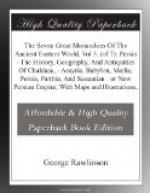[Illustration: PLATE XXIX.]
According to Herodotus, the skulls of the Persians were extraordinarily thin and weak—a phenomenon for which he accounted by the national habit of always covering the head. There does not seem to be in reality any ground for supposing that such a practice would at all tend to produce such a result. If, therefore, we regard the fact of thinness as established, we can only view it as an original feature in the physical type of the race. Such a feature would imply, on the supposition that the heads were of the ordinary size, a large brain-cavity, and so an unusual volume of brain, which is generally a concomitant of high intellectual power.
The Persians seem, certainly, to have been quick and lively, keen-witted, capable of repartee, ingenious, and, for Orientals, far-sighted. They had fancy and imagination, a relish for poetry and art, and they were not without a certain power of political combination. But we cannot justly ascribe to them any high degree of intellectual excellence. The religious ideas which they held in common with the Medes were, indeed, of a more elevated character than is usual with races not enlightened by special revelation; but these ideas were the common stock of the Iranic peoples, and were inherited by the Persians from a remote ancestry, not excogitated by themselves. Their taste for art, though marked, was neither pure nor high. We shall have to consider, in a future chapter, the architecture and mimetic art of the people to weigh their merits in these respects, and, at the same time, to note their deficiencies.
Without anticipating the exact verdict then to be pronounced, we may say at once that there is nothing in the remains of the Persian architecture and sculpture that have come down to us indicative of any remarkable artistic genius; nothing that even places them on a par with the best works of the kind produced by Orientals. Again, if the great work of Firdausi represents to us, as it probably does, the true spirit of the ancient poetry of the Persians, we must conclude that, in the highest department of art, their efforts were but of moderate merit. A tone of exaggeration, an imagination exuberant and unrestrained, a preference for glitter over solid excellence, a love of far-fetched conceits, characterize the Shahnameh; and, though we may fairly ascribe something of this to the idiosyncrasy of the poet, still, after we have made all due allowance upon this score, the conviction presses upon us that there was a childish and grotesque character in the great mass of the old Persian poetry, which marks it as the creation of moderate rather than of high intellectual power, and prevents us from regarding it with the respect with which we view the labors of the Greeks and Romans, or, again, of the Hebrews, in this department. A want of seriousness, a want of reality, and, again, a want of depth, characterize the poetry of Iran, whose bards do not touch the chords which rouse what is noblest and highest in our nature. They give us sparkle, prettiness, quaint and ingenious fancies, grotesque marvels, an inflated kind of human heroism; but they have none of the higher excellencies of the poetic art, none of the divine fire which renders the true poet, and the true prophet, one.




